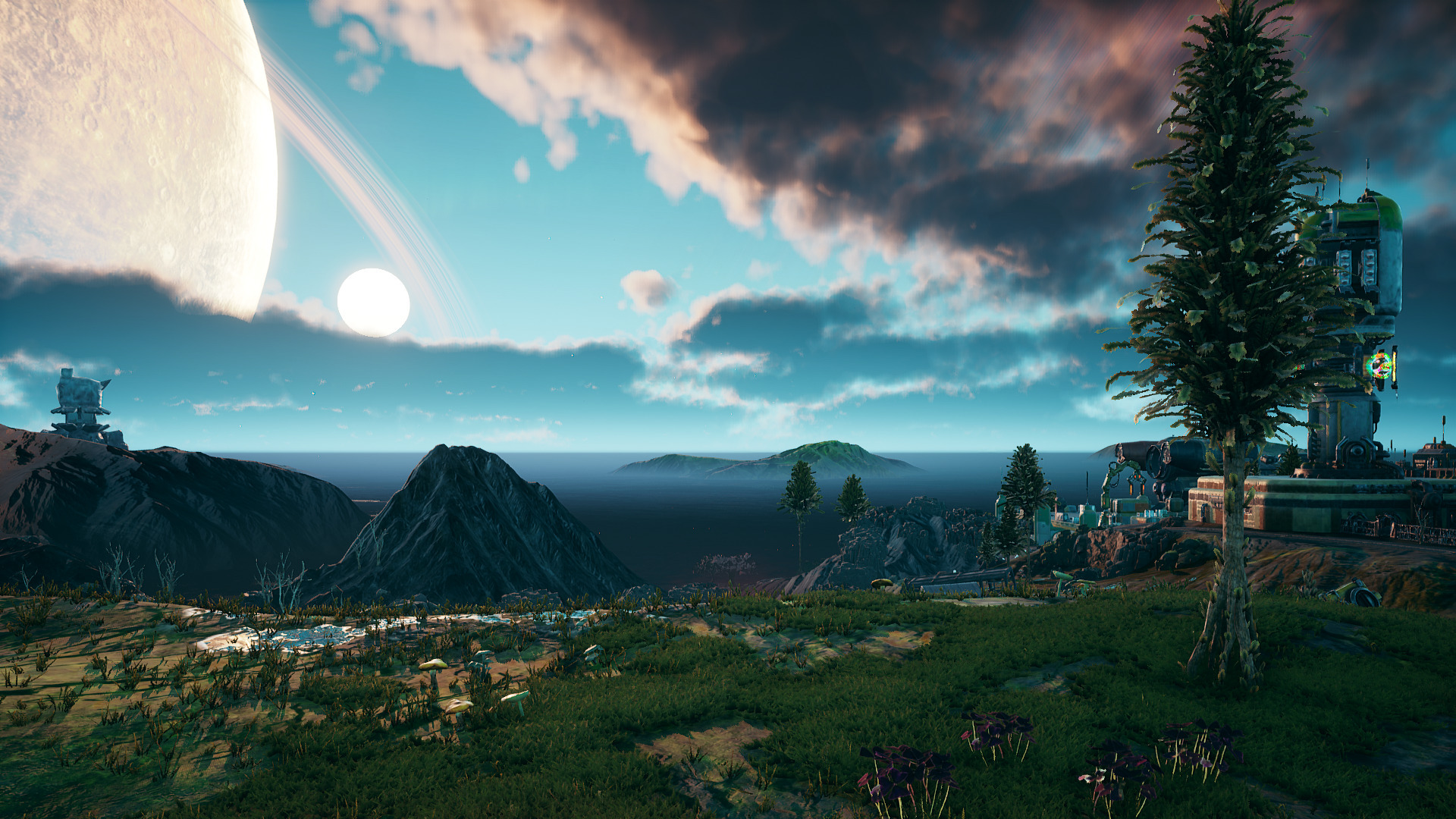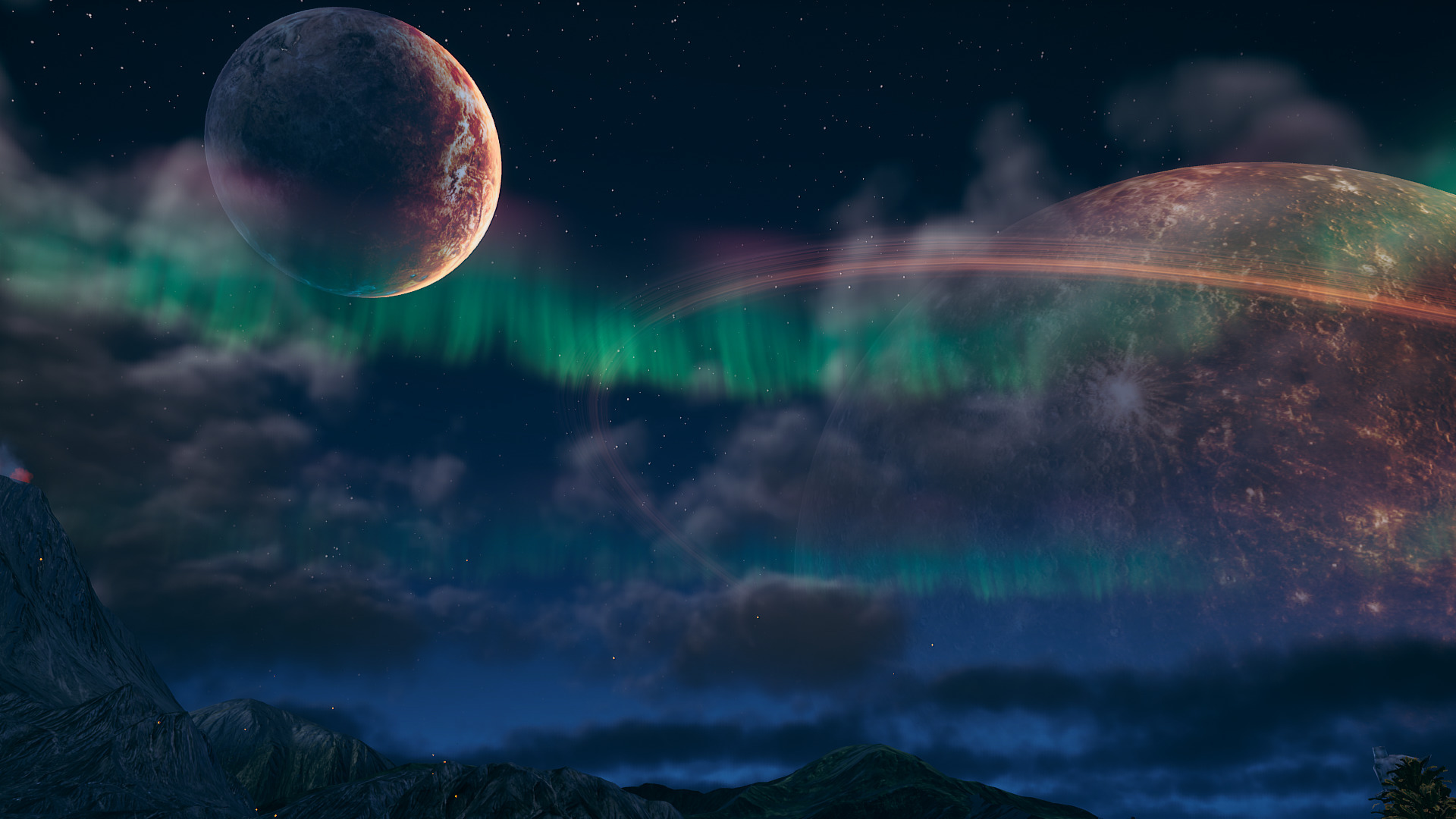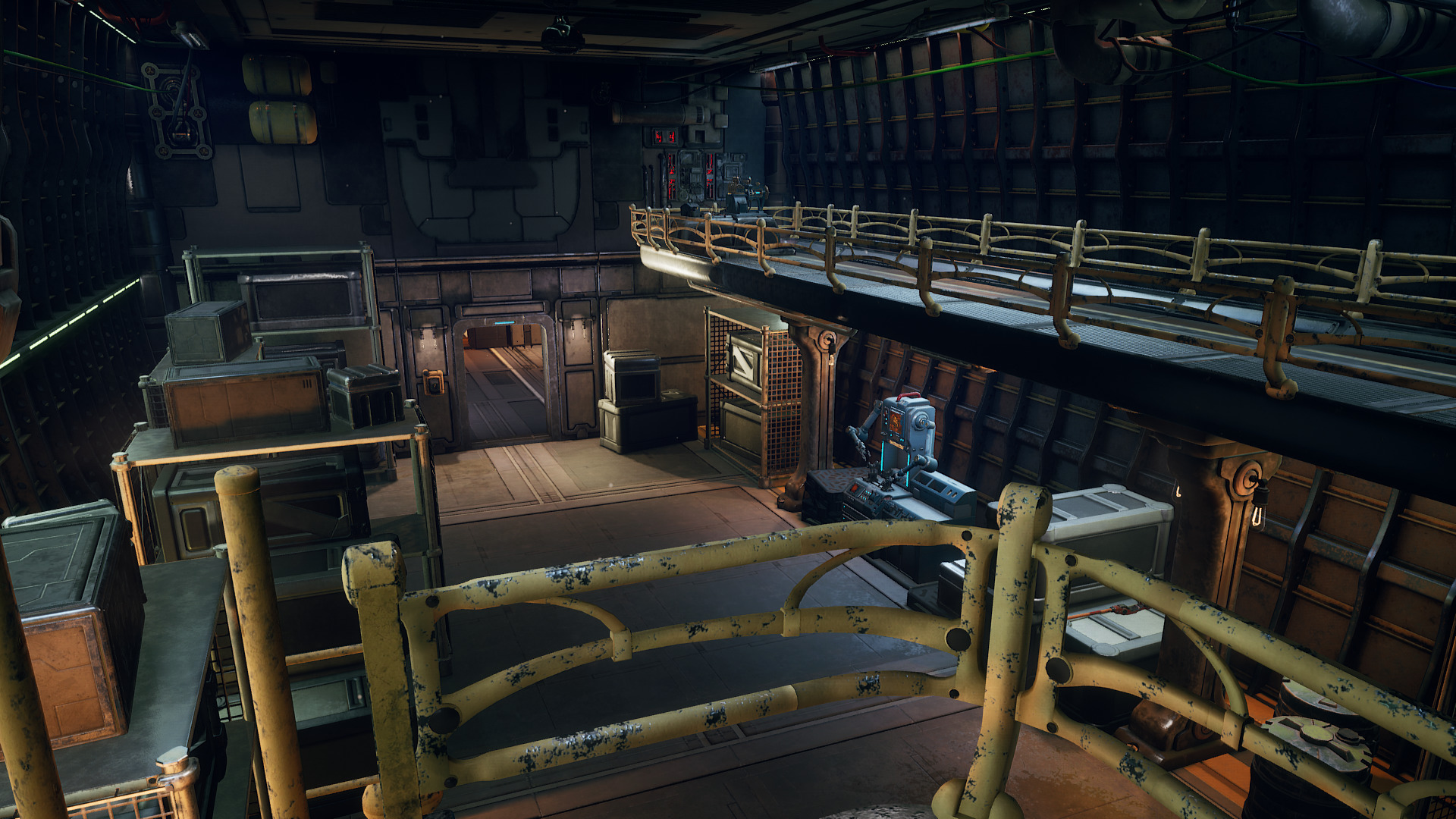The Outer Worlds is a first-person space RPG by Obsidian Entertainment.1 The setting: a struggling 24th century space colony coated in a satire of corporate excess. It’s Fallout by way of Firefly, both in setting and gameplay. Which isn’t a criticism. Obsidian would very arguably be a worthier heir to the Fallout series than Bethesda – after all, it was founded by creators of the first two Fallout games and created the excellent Fallout: New Vegas, a side-entry in the series that does much to harmonise Fallout 1 & 2’s lore and sensibility with Fallout 3’s FPS-inspired gameplay. It was also not responsible for this disaster.
In lieu of Bethesda’s sanction to make another Fallout game, Obsidian created this. It’s got essentially the same gameplay as a modern Fallout title, from the skills- and perks-based levelling system, to the endless container looting, to the lock-picking and hacking mechanics (though without minigames), to the rechargable bullet-time combat mechanic. The Spacer’s Choice moonman mascot is a clear Pip-Boy analogue, and the game’s whole aesthetic is a more colourful and less weather-beaten but still recognisably Fallout-esque retro-futurism. Again, these aren’t criticisms: in a just world, Fallout would be Obsidian’s IP, not Bethesda’s.
So if you’ve been hungering for more New Vegas over the last decade,2 this is your fix. It’s everything Skyrim and Fallout 4 either failed or didn’t try to deliver. Better writing, fewer bugs, and a somewhat versatile character-based experience – you can focus on combat, stealth or diplomacy, side with different factions, and kill just about any NPC in the game, regardless of plot importance. Small improvements over Bethesda-engine games, like conversations being able to support more than one NPC, make the game world feel more dynamic. It’s also much smaller than a Fallout or Elder Scrolls game, and consists of a number of small areas on a few different planets rather than one sprawling, continuous sandbox. This leads to a tightness not present in those games, and is one cause of The Outer Worlds’s significantly lower bug count.
Sunrise in Emerald Vale on Terra 2.
But despite that Obsidian stamp of quality and a high level of general polish, Outer Worlds doesn’t quite escape the shadow of its Bethesda pedigree. Much of its world feels lifeless, populated by miniscule towns with tiny populations that don’t do much more than stand around. Gameplay is limited to two modes: running and gunning, and clicking through dialogue trees. There are no vehicles, spectacular set-pieces, or anything else to make the game world feel dynamic or break up the monotony. Few locations evoke a real sense of scale, and the player’s spaceship may as well be a hall of portals (ala A Hat in Time), as space travel happens in fade-ins. While some effort is made to reflect major status-quo-changing events, such as the outcome of the player’s first large mission in the settlement of Edgewater, playing quests and talking to NPCs in an unexpected order quickly pokes holes in the illusion.
Many of these things were understandable and even excusable for Fallout: New Vegas, built on Bethesda’s Fallout 3 engine, but their reintroduction in an original game with a new engine is disappointing. Perhaps Obsidian didn’t want to stray too far from a model that, after all, has been the basis for a slew of wildly beloved and popular games, or perhaps (most likely) it came down to budget.
The game’s main strength is its writing and quests. An easy trap to fall into when writing quests is to make them straightforward tasks: kill ten of X creature and bring their hides to Y person for payment. Such a simple quest is not a story but an errand. For it to become a story, something unexpected must happen between the player embarking on the quest and completing it, which should lead to a different conclusion from what was expected at the outset, or at least a different understanding of the expected conclusion. In an interactive context, the player should also have a choice about how the quest is completed, at least some of the time.
Nothing says alien sky like a really close ringed planet.
New Vegas excelled at just these kinds of engaging quests. A personal favourite, Come Fly With Me, starts with an innocuous request to clear a pack of feral ghouls out of an abandoned rocket test site. In a lesser game, this would be an errand: kill X ghouls and report back. Instead, you enter the test site and find a group of very much non-feral ghouls who belong to an earnest cult, and ask you for help clearing out the nightkin in the facility’s basement. In turn, the nightkin have their own hostile infestation problem, and you have to choose how to deal with that. Ultimately, you have to decide who to help and who to kill, and there are multiple more or less bloody ways to complete the quest. By the end of it, you’ve been through an actual adventure, not merely an exercise in XP grinding.
The Outer Worlds delivers some of this sort of thing, though it never quite reaches the gonzo delight of Come Fly With Me. Most of the longer quests have at least one twist and provide multiple options for resolution, and even shorter quests generally present a bit more context and interest than “fetch some things for the quest-giver”. Even so, you never lose the sense that you’re in complete control of how things are going to play out. Twists that reveal an agency besides your own are few and far between.
A rare moment of thrill for me came in a late-game quest for a morally (and legally) grey faction. The player is busy scavenging something in a place they’re not allowed to be in when they are suddenly contacted by law enforcement. The player then has to talk or fight their way out of having their quest completely derailed. This was a small touch, and ended quickly in my case thanks to my character’s high Persuasion skill, but it made it feel, for once, as though my character wasn’t the only proactive agent in the galaxy.
The Outer Worlds doesn’t throw many of these kinds of curveballs at the player, and not necessarily for the aforementioned reasons of pedigree. The only quest I clearly remember from the hundreds of hours I dumped into Oblivion about fifteen years ago had this element of surprise. It was the first quest I completed in the game, following the tutorial, and gave me unreasonably high hopes for the rest of the game. Much of the delight was that I hadn’t expected a quest at all when I paid for a bed at the interesting-looking boat-based inn in the Imperial City. I was just after a night’s rest, but upon waking found that the boat had drifted out to sea, having been hijacked by pirates that I had to now fight off and wrest control of the ship from if I hoped to see land again.
The Bloated Float out at sea (Oblivion).
Considering the player’s ship is named “The Unreliable”, Obsidian really missed a trick not including an “Out of Gas”-style quest in deep space – this would go a long way to remedying the hall-of-portals feeling of the player’s ship.
That it doesn’t do much of this stems from the game’s strong aversion to player inconvenience, which ties into the story’s player worship. This is most blantantly showcased by the game’s ending slideshow (a Fallout staple) which summarises the fates of the various factions and characters the player interacted with through the game. The narrator goes on about the player’s great exploits in Halcyon and how they made such an enormous difference to the places and peoples they encountered and will be immortalised in legend.
This sort of thing is hard to avoid in RPGs (and other narrative-heavy videogames) but it’s another area where New Vegas outdoes its successor. Unlike in that game, the good ending is unambiguously good and the bad ending unambiguously bad. Caesar’s Legion had a twisted kind of rationale, but the Board is pure self-interested evil. The NCR is overstretched and might not be the best government for the Mojave, but Phineas Welles may as well be Space Jesus. Wait, no, that’s the player.
The player is the all powerful Stranger, who lands in Halcyon and single-handedly solves everyone’s problems, mows down swathes of alien beasts and armed bandits, and accumulates enough XP to become a godlike being. The game world exists for their amusement and is at their beck and call. Quests are, for the most part, designed to accommodate each other, so the player can experience as much delicious gameplay content in one playthrough as possible. They can spend almost the whole game playing sides off each other and keep everyone happy so that all quests remain open. And if they are Good, they will reach the Good Ending with no need for trade-offs and no room for doubt.
The Outer Worlds shines in the few places where it subverts this player subservience. In one notable late-game quest, the player has to choose between murdering an important character and losing the favour of a particular faction. In contrast with much of the rest of the game, there’s no way to talk through this quest and keep both sides happy. Seeing my reputation go down with a faction for once was quite refreshing.
The hold of the player’s ship, designed in rigorous compliance with sci-fi regulations.
Although The Outer Worlds allows you to choose between fighting, sneaking and talking your way through its various quests, it’s clear that most of the love has gone into fighting. There are some sections where you’re encouraged to use stealth and a neat disguise mechanic, but they feel fairly perfunctory. And talking your way through the game really just amounts to skill checks, which feel like cheat codes that let you skip parts of the game.3 In any case, you won’t be talking your way past a Mantiqueen.
Despite being set across the breadth of a solar system, The Outer Worlds boasts few unique enemies and loot dull enough to kill even the most compulsive container-opening spirit. The science weapons are kind of interesting though.
All that aside, I did enjoy The Outer Worlds enough to play through the whole thing including all the side quests. It’s not an incredibly memorable or novel experience, but it’s easily the second-best Bethesda-style RPG to date. I only hope that Obsidian’s future games are more ambitious, willing to take more risks and interested in telling more morally complicated stories.
-
It’s also one of the more high-profile Epic Store exclusives. If you’re a Steam die-hard who can’t bear the thought of downloading and registering on a second game client (for free), you’ll only be able to play it this October. ↩︎
-
New Vegas came out ten years ago. Truly, time was ago. ↩︎
-
As I said in my review of Undertale, pacifism in most games is an exercise in intentionally skipping core mechanics. ↩︎
 David Yates.
David Yates.